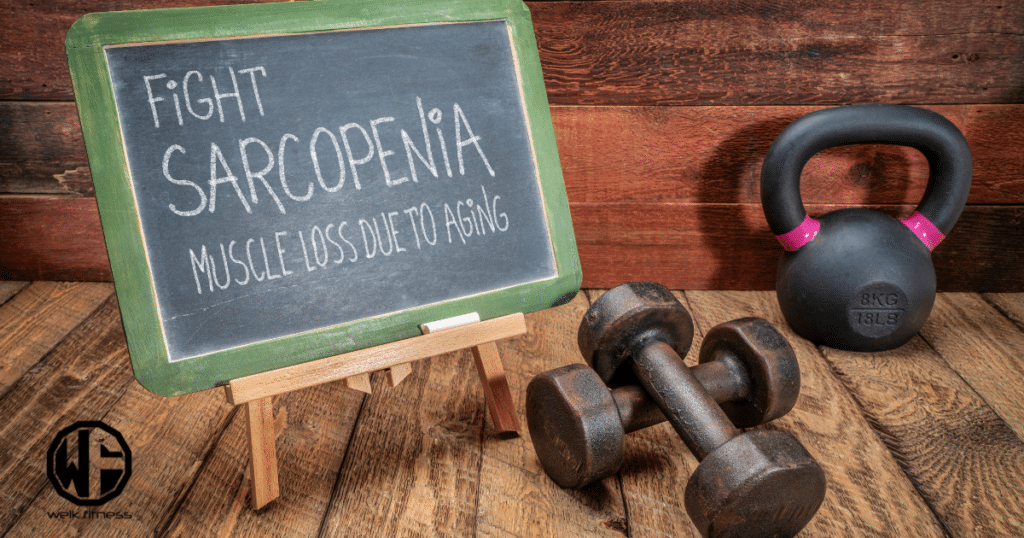Preventing Sarcopenia: Strategies for Maintaining Muscle Mass
In a relentless battle against time, there’s something that creeps silently upon us, threatening to rob us of our strength and lean muscle mass. It hides in the shadows, preying upon our aging bodies, sowing seeds of doubt and insecurity. Its name is sarcopenia, a sinister condition that gradually steals away our hard-earned muscle mass, leaving us vulnerable and frail.
Dramatic, right? But the struggle is real. As the years pass, this relentless enemy gnaws away at our once-mighty physique, replacing it with a weakened and less muscular physique. Brace yourself for impact, sarcopenia doesn’t care who you are. It’s coming whether you like it or not. The question becomes, how do you prevent it?
Throughout the article, we will dive deeper into sarcopenia and help you better understand what it is, how it robs you of your lean muscle mass, and what you can do to help prevent it.

Disclaimer: This article is for informational purposes only and is not meant to treat or diagnose any condition. It is recommended that you speak to your doctor before starting or changing your nutrition or workout regimen.
Table of contents
What is Sarcopenia?

Sarcopenia refers to the age-related loss of skeletal muscle mass, strength, and function. It is a natural process that occurs as part of the aging process, typically starting around the age of 30 — about the same time your natural testosterone production starts to take a nosedive. However, the rate of muscle loss tends to accelerate at a much faster rate after the age of 50.
Related Article: How to Naturally Fight the Aging Process
Several factors contribute to the development of sarcopenia. These include hormonal changes (such as a decline in testosterone and growth hormone levels), reduced physical activity, poor nutrition, chronic diseases, inflammation, and increased levels of oxidative stress.
Sarcopenia can have significant consequences on your overall health and quality of life. It can lead to decreased muscle strength, reduced mobility, increased risk of falls and fractures, impaired balance, and a decline in functional independence — all of which tend to materialize after you reach the age of 50. It can also affect metabolic health, as muscle tissue plays a crucial role in energy expenditure and glucose metabolism. It’s for this reason that after reaching the age of 30, you may think your metabolism has gone on vacation, and you’re more easily storing body fat.
While sarcopenia is primarily associated with aging, it is not an inevitable consequence of getting older. Regular exercise, particularly resistance training, along with a balanced diet high in quality protein and other essential nutrients, can help prevent or mitigate the effects of sarcopenia. Early detection, awareness, and proactive lifestyle choices are key to managing and combating sarcopenia effectively.
What are the Main Factors That Contribute to Sarcopenia?

Sarcopenia is influenced by several factors that contribute to the age-related loss of muscle mass, strength, and function. Understanding these factors can help in developing strategies to prevent or manage the effects of sarcopenia.
Below are some of the main contributors to sarcopenia:
1. Aging Process
Sarcopenia is primarily associated with the natural aging process, which everyone goes through as Father Time doesn’t care if you’re a celebrity or have a fancy checkmark next to your social media handle saying you’re verified. As individuals age, physiological changes occur in the body, including a decrease in muscle protein synthesis and an increase in muscle breakdown. These changes lead to a gradual loss of muscle mass and strength over time.
2. Hormonal Changes
Hormonal changes can play a role in sarcopenia. With aging, there is a decline in natural anabolic hormone production, such as testosterone, growth hormone, and insulin-like growth factor 1 (IGF-1). These hormones are essential for muscle growth and repair. This decline in hormone levels can contribute to reduced muscle protein synthesis and lead to muscle loss. That said, if you want to naturally boost your testosterone levels, here’s a product I use and recommend to my clients for elevating testosterone production.
3. Sedentary Lifestyle
Lack of physical activity and a sedentary lifestyle are significant contributors to sarcopenia (along with many other risk factors and diseases). When muscles are not regularly stimulated through exercise, they undergo atrophy (shrinkage) and lose their strength. Physical inactivity also affects factors like insulin sensitivity and hormone regulation, further accelerating muscle loss.
4. Poor Nutrition
Inadequate nutrition, particularly low protein intake, can contribute to sarcopenia. Protein is essential for muscle synthesis and repair. Insufficient protein intake can hinder the body’s ability to build and maintain muscle mass. If your goal is to maintain or build muscle, strive for around 1g of protein per pound of body weight. For example, if you’re 200 pounds, try to hit 200g of protein daily. Additionally, inadequate intake of other nutrients, such as vitamins and minerals, can affect muscle health and overall function. Furthermore, poor nutrition can negatively affect hormones, leading to fat storage, which can also change your musculature and metabolism.
5. Chronic Diseases
Certain chronic diseases can accelerate muscle loss and increase the risk of sarcopenia. Conditions such as diabetes, cardiovascular disease, cancer, and chronic obstructive pulmonary disease (COPD) can impact muscle health through various mechanisms, including inflammation, metabolic changes, hormonal imbalances, and reduced physical activity.
6. Inflammation and Oxidative Stress
Chronic inflammation and increased oxidative stress are associated with sarcopenia. Inflammation can disrupt muscle protein synthesis and promote muscle breakdown. Oxidative stress, which occurs when there is an imbalance between the production of reactive oxygen species (ROS) and the body’s antioxidant defenses, can damage muscle tissue and impair muscle function.
7. Medications
Certain medications, such as corticosteroids, some antidepressants, and anticonvulsants, can contribute to muscle loss and weakness. These medications may affect muscle protein synthesis or lead to increased muscle protein breakdown.
It’s important to note that while these factors contribute to sarcopenia, they are not deterministic. Lifestyle modifications, including regular exercise, a balanced diet, and overall healthy habits, can help mitigate the impact of these factors and promote muscle health. Additionally, working closely with your doctor can help address specific concerns related to chronic diseases, medication management, and nutritional needs.
How Can You Prevent Sarcopenia?

Preventing sarcopenia involves adopting a holistic approach that incorporates regular exercise, proper nutrition, and lifestyle modifications. You’ve probably heard these things quite often as we all age.
Below are some strategies you can implement to help prevent sarcopenia:
· Resistance Training
Engage in regular resistance exercises, such as weightlifting or bodyweight exercises. These activities stimulate muscle growth and help maintain muscle mass and strength. Focus on exercises that target major muscle groups and gradually increase the intensity over time through progressive overload.
· Aerobic Exercise
Include aerobic activities like brisk walking, cycling, or swimming in your routine. Aerobic exercise enhances overall cardiovascular health and supports muscle function.
· Balanced Diet
Consume a well-balanced diet that includes an adequate amount of high-quality protein, such as lean meats, poultry, fish, eggs, dairy products, legumes, and tofu, if you want to help slow down the rate of sarcopenia. Protein is essential for building muscle following resistance training and assisting the torn-down muscle fibers recover and repair. Additionally, ensure you get sufficient amounts of vitamins, minerals, and antioxidants through a varied diet of fruits, vegetables, whole grains, and healthy fats. Consider leveraging supplements if you’re not getting enough through your diet alone.
· Vitamin D
Maintain sufficient vitamin D levels, as it plays a crucial role in muscle function and can help slow sarcopenia. Get regular sunlight exposure, consume vitamin D-rich foods like fatty fish and fortified dairy products, or consider a vitamin D supplement if needed. This can be especially important in the colder months when the sun sets earlier, and your exposure to natural sunlight becomes more limited.
· Stay Active
Lead an active lifestyle and avoid excessive sedentary behavior. Incorporate movement throughout the day, such as taking breaks to stretch or walk, using stairs instead of elevators, or participating in hobbies that involve physical activity, like taking walks or hikes with family or friends. Strive for 150 minutes of activity per week to unlock the health benefits.

· Limit Alcohol and Tobacco
Excessive alcohol consumption and smoking can have detrimental effects on muscle health and can further cause sarcopenia. Minimize alcohol intake and avoid smoking to support muscle maintenance.
· Manage Chronic Conditions
If you have chronic conditions like diabetes, cardiovascular disease, or osteoporosis, work closely with your doctor to manage these conditions effectively. Controlling these conditions can help mitigate sarcopenia.
· Adequate Sleep
Prioritize quality sleep to support overall health, muscle recovery, and hormonal balance. Strive for 7-8 hours of uninterrupted sleep per night.
· Regular Health Check-Ups
Regularly visit your doctor for check-ups and screenings to monitor your overall health, including muscle mass and function.
Remember, it’s never too late to start implementing these preventive measures. Even small lifestyle changes can positively impact muscle health and help prevent or slow down the progression of sarcopenia.
No One Beats Father Time — All We Can Do is Better Manage the Aging Process and Sarcopenia
The battle against sarcopenia is not one to be taken lightly. Armed with the knowledge of its contributing factors, you can defy the relentless grip of muscle loss.
Related Article: Bodybuilding Can Slow the Aging Process at the Cellular Level
You can turn the tide in your favor by embracing regular exercise, nourishing your body with a balanced diet, and making conscious lifestyle choices.
If you choose to leverage the information provided in this article, you can rise above the challenges of sarcopenia and help maintain your muscle mass and strength. The path to muscle preservation and preventing sarcopenia is essential to your longevity and independence as you age. It is time to step forward with unwavering determination, knowing you can unlock the door to lasting strength, health, and youthful vigor.


*Disclosure: This article may contain affiliate links or ads, which means we earn a small commission at no extra cost to you if you make a purchase through these links. These commissions help support the operation and maintenance of our website, allowing us to continue producing free valuable content. Your support is genuinely appreciated, whether you choose to use our links or not. Thank you for being a part of our community and enjoying our content.
PLEASE CONSIDER SHARING THIS ON YOUR SOCIAL MEDIA TO HELP OTHERS LEARN MORE ABOUT THIS TOPIC. SIMPLY CLICK BELOW!

